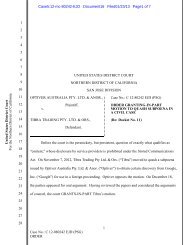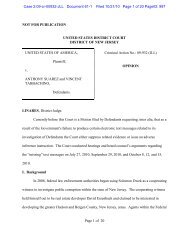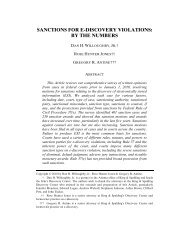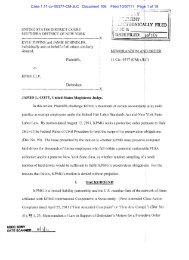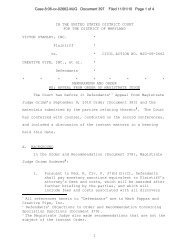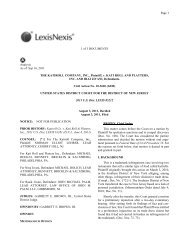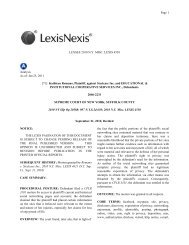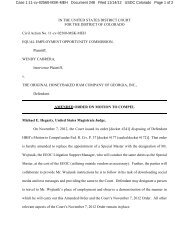Rimkus Consulting Group Inc. v. Cammarata - Ballard Spahr LLP
Rimkus Consulting Group Inc. v. Cammarata - Ballard Spahr LLP
Rimkus Consulting Group Inc. v. Cammarata - Ballard Spahr LLP
Create successful ePaper yourself
Turn your PDF publications into a flip-book with our unique Google optimized e-Paper software.
Case 4:07-cv-00405 Document 450 Filed in TXSD on 02/19/10 Page 114 of 139<br />
discovered by improper means; and (3) show that the defendant used the trade secret without<br />
authorization from the plaintiff.” Gen. Univ. Sys., <strong>Inc</strong>. v. Lee, 379 F.3d 131, 149–50 (5th Cir.<br />
2004). To determine whether information is a trade secret protected from disclosure or use,<br />
a court must examine six “relevant but nonexclusive” criteria: “(1) the extent to which the<br />
information is known outside the business; (2) the extent to which it is known by employees<br />
and others involved in the business; (3) the extent of measures taken to safeguard the secrecy<br />
of the information; (4) the value of the information to him and to his competitors; (5) the<br />
amount of effort or money expended in developing the information; and (6) the ease or<br />
difficulty with which the information could be properly acquired or duplicated by others.”<br />
Id. at 150 (citing In re Bass, 113 S.W.3d 735, 739–40 (Tex. 2003)); T-N-T Motorsports, <strong>Inc</strong>.<br />
v. Hennessey Motorsports, <strong>Inc</strong>., 965 S.W.2d 18, 22 (Tex. App.—Houston [1st Dist.] 1998,<br />
pet. dism’d). All six factors need not be satisfied “because trade secrets do not fit neatly into<br />
each factor every time.” Gen. Univ. Sys., 379 F.3d at 150 (quoting Bass, 113 S.W.3d at 740).<br />
Courts in Texas identify trade secrets, proprietary information, and confidential<br />
information separately but provide them similar protection if the requirements—including<br />
that of secrecy—are met. 41<br />
“Use”of a trade secret refers to “commercial use” and occurs<br />
41 See, e.g., Gallagher Healthcare Ins. Servs. v. Vogelsang, --- S.W.3d ----, 2009 WL 2633304, at *10 (Tex.<br />
App.—Houston [1 Dist.] 2009, no pet. hist.) (“Moreover, a covenant not to compete is enforceable not only<br />
to protect trade secrets but also to protect proprietary and confidential information.”); Norwood v. Norwood,<br />
No. 2-07-244-CV, 2008 WL 4926008, at *8 (Tex. App.—Fort Worth 2008, no pet.) (mem. op.) (“But a<br />
former employee may not use confidential or proprietary information or trade secrets the employee learned<br />
in the course of employment for the employee’s own advantage and to the detriment of the employer.”);<br />
Bluebonnet Petroleum, <strong>Inc</strong>. v. Kolkhorst Petroleum Co., No. 14-07-00380-CV, 2008 WL 4527709, at *5<br />
(Tex. App.—Houston [14 Dist.] 2008, pet. denied) (mem. op.) (“The issue, therefore, is whether the mere<br />
identity of the potential accounts with which Robinson was working when he left Bluebonnet is a trade secret,<br />
or even merely proprietary information accorded similar protection. To decide whether the information<br />
qualifies as a trade secret we must consult the six factors listed above.”); SP Midtown, Ltd. v. Urban Storage,<br />
114



